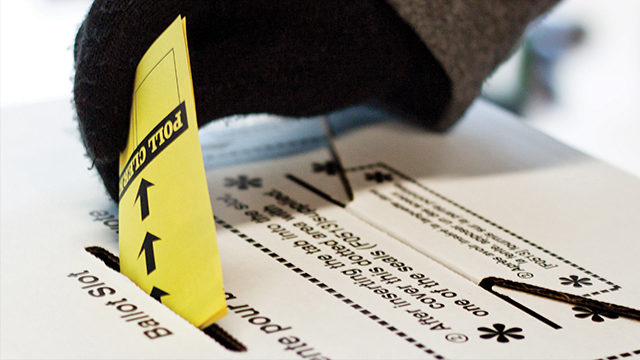
Ryerson plans to help students navigate Fair Elections Act
By Peter Goffin
With the 2015 federal election just over a month away, Canadians face a new set of voter identification rules that some critics say may discourage university students from going to the polls.
Among other voting regulation changes, the Fair Elections Act has banned two means of voting for people who do not have a photo ID with their name and current address on it. The Voter Information Card, mailed to all registered voters, will no longer be accepted at the polls as sufficient proof of where a person lives.
And the vouching system (under which a voter with sufficient ID guarantees the eligibility of another voter) has been replaced by a more intricate process, under which a voter without ID must swear an oath and show two pieces of identification with their name on it, while also having another voter from their area testify.
When Democratic Reform Minister Pierre Poilievre introduced the Fair Elections Act in February 2014, the government said these new restrictions on ID were in response to “mass irregularities in the use of vouching and high rates of inaccuracy on Voter Information Cards.” But critics have said the new rules will only make it harder for many Canadians — including post-secondary students—to vote.
Chief Electoral Officer Marc Mayrand told a parliamentary committee in 2014 that the Fair Elections Act would, in his opinion, make it harder for young people, as well as First Nations and seniors, to vote, since these groups are most likely not to have government-issued ID or official documents with their names and addresses.
“I do not believe that if we eliminate vouching and the VIC as proof of address we will have in any way improved the integrity of the voting process,” Mayrand said. “However, we will certainly have taken away the ability of many qualified electors to vote.”
At time of publication, Poilievre had not responded to The Ryersonian’s email requests for comment. However, in a 2014 opinion piece for the Globe and Mail, the minister wrote that, “Canadians instinctively understand that these changes are reasonable and fair. That is why they have not shared the critics’ hysteria.”
Ryerson University is taking steps to ensure on-campus students can vote on Oct. 19.
Ian Crookshank, Ryerson’s director of housing and residence life, said the university will be using one of two methods to allow students living on campus to prove their current address at the polls.
For last year’s municipal election, Ryerson sent an official proof-of-address letter to each on-campus student to show at the polls.
The other option, which Ryerson has also used in previous elections, is to provide the on-campus polling stations with complete lists of all eligible students who live in Ryerson residences.
Crookshank said the university is in talks with Elections Canada and will know later this week which method will be used.
But students living off-campus need a piece of photo ID to prove their identity, and, additionally, a document that indicates their current address, such as a lease or a hydro bill.
That could be a problem, said Craig Scott, NDP critic for Democratic and Parliamentary Reform. So few university and college students have documents readily at hand with their current addresses on them, he told The Ryersonian. Bills for a student’s housing may only go to one roommate, and all forms of ID are likely to show the address of a student’s parents’ house, not their school-year home.
While students can always go back home to cast their ballot, Scott said, he believes the added step will make it much less likely they will vote.
“We know that when university students have to go out of their way in the middle of term … the chances that they’re actually going to line everything up and vote are much lower than if they could easily vote where they are going to university.”
What you can use as ID at the polls:
- One piece of government-issued ID with your name, photo and current address.
- Two documents with your name on them, of which one has your current address. This could be a passport and a bill, a health card and a bank statement.
- A full list of acceptable IDs is available at Elections Canada’s website.